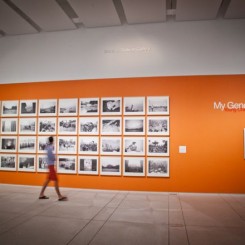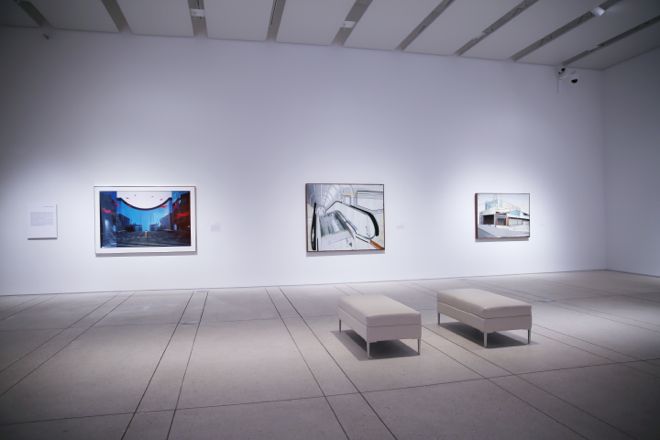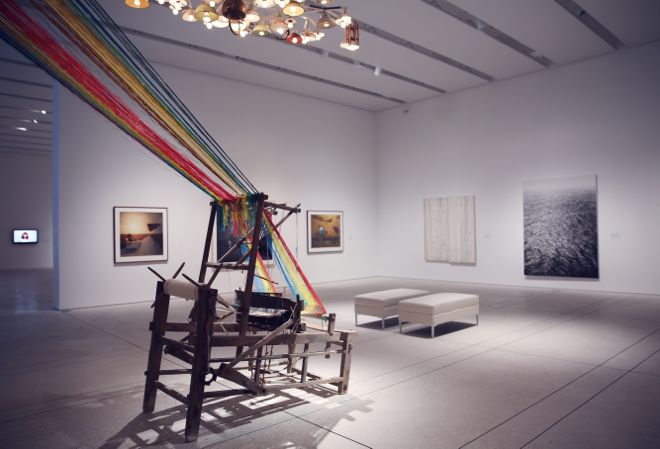“My Generation: Young Chinese Artists”
Tampa Museum (120 W Gasparilla Plaza, Tampa, FL 33602, USA), Jun 7 – Sept 28, 2014
Museum of Fine Arts (255 Beach Drive N.E., St. Petersburg, FL 33701), Jun 7 – Sept 28, 2014
“My Generation: Young Chinese Artists” is New York-based critic, curator, writer and journalist Barbara Pollack’s well-chosen introduction to new Chinese art and artists. Installed in two venues, the Tampa Museum of Art and the St. Petersburg Museum of Fine Arts (through September 28th), it is the first exhibition in the United States to exclusively showcase the work of the post-Reform and Opening (1978–79 onwards) generation. All from mainland China and born after 1976, these artists’ live in a more liberalized and more consumer-oriented country than their predecessors, one that has shifted at warp speed from a traditional agrarian society into a modern industrial nation, signaling a radical societal upheaval for the third time in a century.
The exhibition emphasizes how much these YCAs (“Young Chinese Artists”—with the exhibition title, Pollack deliberately refers to the widely acclaimed YBAs, Young British Artists of the late ’90s) differ in attitude from the Chinese artists who first came to the attention of the international art world. In addition, she said that YCAs emphatically avoid dragons, lanterns, pagodas, and other clichéd, retrograde motifs—“As much influenced by Martin Kippenberger as by Zhang Xiaogang.” If these images appear—and they do, on occasion— it is in a double-edged way; from a self-conscious, critical point of view that is also critical, perhaps, of viewers who expect to see them. However, the most compelling aspect of the show is that these artists, in language that is contemporary, international, original and at times disruptive, vividly recount their present concerns as inhabitants of one of the fastest-developing countries in the world—its illuminated sky-high towers, multi-level roadways and state-of-the art technologies evidence of its position as the world’s second largest national economy.
Consisting of 27 Chinese artists (for the record, around a third are women, to Pollack’s credit) working in painting, installation, sculpture, video and photography, it was divided between the two venues, roughly separated into the political and the personal, with subheadings that include urbanization, familial relationships and religion, the themes treated both seriously and with edgy humor, as seen, for example, in Double Fly Art Center’s “Double Fly Saves the World” (2012) in which the all-male collective irreverently, scatalogically pokes fun at world leaders.
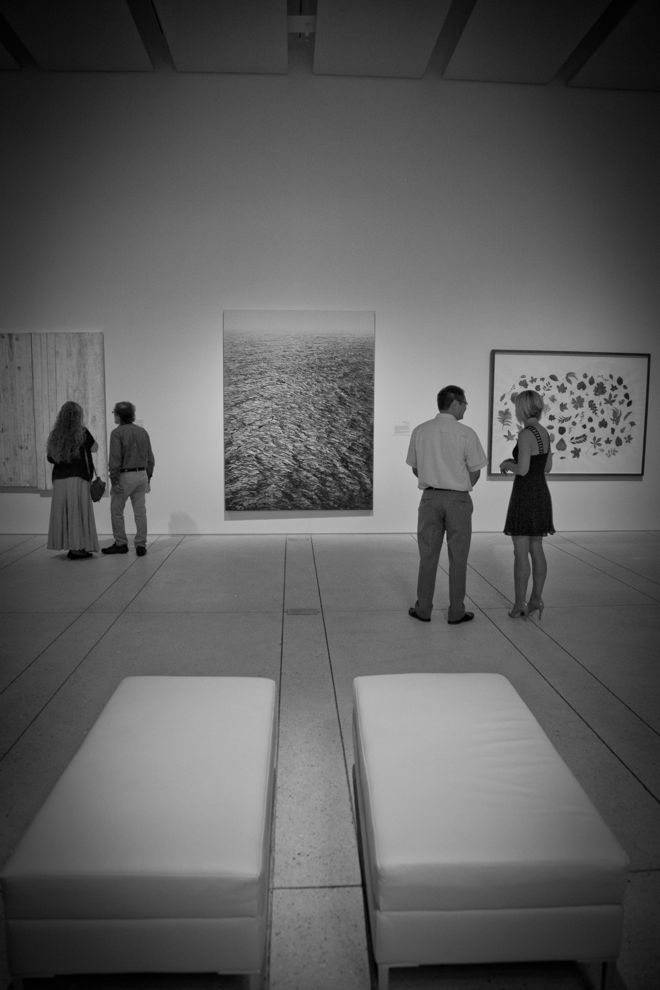
Shi Zhiying, “The Pacific Ocean”, oil on canvas, 240 cm x 180 cm (94 1/2 in x 70 5/16 in), 2011, Courtesy of a private collection and James Cohan Gallery, Shanghai
The first work in the St. Petersburg museum, appropriately enough, is what might be called a reconfigured, abstract version of a traditional Chinese entry way by Zhang Ding, the flanking stone lions or guardian figures replaced by shining circular black discs wrapped in dangerously sharp razor wire —not harmful if given space but capable of inflicting deep wounds if one is imprudent and comes too near (an apt emblem of an authoritarian state). “Untitled” (2013) also demonstrates that artists can delve deeply into political issues without encountering censorship if they are not explicit. Another pointed but amusing instance of this is performance artist Hu Xiangqian’s video, “Flying Blue Flag” (2006). He filmed himself going house to house to solicit votes for his candidacy for mayor of his hometown, inventing a party, the Blue Flag, as his sponsor, offering outright but ludicrously small bribes, such as a single cigarette for a vote—a commentary on the pervasive political corruption that extends from the highest echelons of the government to the lowest. So persuasive was he as a candidate, and so appealing, that when the townspeople went to vote, they were deeply disappointed that he wasn’t on the ballot.
One of the highlights of the exhibition is Sun Xun’s remarkable video animations and the ambitious installation of countless works on paper from his “library of images,” as he calls it. It’s a project, as most of his projects are, influenced by the recent history of China as told by his father, grandfather and their friends, a more somber version at odds with the official party narrative. The message he stresses is how governments in general disseminate and manipulate information, the recurrent image of a magician performing tricks in his videos his symbol for the politician.
Another, “Fearless” (2012) is an enormous wall-sized tapestry with high-relief appliqués by Xu Zhen/MadeIn, a mélange of deracinated, appropriated images of Western culture taken from the internet which is a critique of contemporary Chinese art production. This extends to shanzhai—the culture of fakes that is endemic in China and elsewhere in the East in which fake and authentic are difficult to distinguish— in part because copying historically was not considered negatively but as an act of veneration and instruction. Pollack, interestingly, includes artists who address this issue more subtly, as a conceptual act or as trompe l’oeil rather than fraud. Liang Yuanwei, for instance, makes paintings that look like Chinese silk embroidery (“Diptych Painting” from 2010 is an example here) while Hu Xiaoyuan painstakingly inks the fine grain of wood on silk and then seamlessly attaches the delicate fabric to the wooden panel, the simulated pattern mistaken for the real (in works such as “Wood Pair”, 2010-11).
Yet another tour de force is the technically stunning, brightly colored 3-D animation of Yamantaka, the many-armed Tibetan Buddhist god of wrath by Lu Yang (“Wrathful King Kong Core”, 2011). One component of the installation, accompanied by pulsing techno-music, is a brain scan of the god that was then analyzed by a neuroscientist who probed the physiological roots of its rage to determine the appropriate psychotropic drug to administer, provocatively joining Buddhism with 21st Century science.
At the Tampa Museum, urbanization and the artists’ individual responses to it form the principal narrative thread as they come to terms with a China which, intent on modernization, has razed much of its past, destroying their childhood homes and early memories. Several enormous paintings greeted the viewer entering the main gallery, including Qiu Xiaofei’s beautifully textured “Utopia” (2010), its subject, underscored by the gritty surface, the demolition and reconstruction of Beijing for the 2008 Olympics and Shi Zhiying’s “The Pacific Ocean” (2011), once the definitive border between China and the rest of the world. Seeing the ocean while in California, looking eastward, was the impetus for a spiritual reawakening for the artist. This is reflected in the painting’s monochromatic immensity and repetitious brushstrokes as a kind of visual Buddhist chant, invoking infinity.
There is also an arresting 20-ft. long white tyvek sculpture by Jin Shan of a Futurist structure, its façade shadowed by a projection of a peony, flying crane and sun. Called “No Man’s City” (2014), it refers to his artist Father’s history during the Cultural Revolution as a government stage designer. The nine-member collective Irrelevant Commission, contributed a video sequence in which the artists asked their family what they thought art is. Working in collaboration with their family is their trademark, and like Hu Xiangqian’s performance video, they take you directly inside ordinary Chinese homes; in “About Family” (2011), an installation, Yu Nan made a chandelier from metal dishes that belonged to his Grandfather and the loom used to make a rainbow of multi-colored threads by Li Liangyong belonged to her grandmother.
Photography and video are abundant here, among them the series of beautifully staged, subliminally disquieting pictures by Chen Wei of urban interiors called Some Dust from the Everything, Scenery and Props, 2009. There is also the striking, monumental photograph by Chi Peng of a blue glass building in a Beijing eerily devoid of people except for the naked, solitary figure of the artist, a blur of small red airplanes wheeling overhead, his back to us, standing on the great staircase leading up to it (“Sorinting Forward 4”, 2004). In contrast, there is also an immersive grid of photographs of events in the daily lives of the Shanghai duo Birdhead and their friends that is similar to the endless stream of images available on social media. The videos include Ma Qiusha’s disturbing performance “From No.4 Pingyuanli to No. 4 Tianqiaobeili” (2007) in which she is shown facing the camera, speaking slowly as she talks about her life with unusual intimacy, revealing at the end (you should see for yourself) why she was speaking so hesitantly, the self-mortification of the body a thread often found in contemporary Chinese performance art. Huang Ran’s video “Disruptive Desires, Tranquility and the Loss of Lucidity” (2012), is also deceptive —its dream-like pastoral ambience belying the darker psychological undercurrents that gradually emerge, the tension between beauty and latent transgressions the source of its unsettling allure.
More straightforward is a series of short, informative interviews with 14 artists in the show filmed by Max Berger, recounting their experiences as Chinese artists today. Overall, the show is admirably diverse, balanced between the serious and the comedic. the artists’ works offer a focused exploration of current issues, sometimes startlingly personal, which might mark the biggest shift in expressive attitudes. No longer as reactive to external forces, these young artists have forged their own themes and their own lexicon in their own image— their contribution to the polyphonic, multi-conscious global discourse. For those who are encountering contemporary Chinese art for the first time, “My Generation” should be particularly enlightening—as well as refreshing. For those who are more familiar with it, the show offers the substantial reward of individual works by rising artists that uniformly merit high marks. Not a copy, “My Generation” gives made in China renewed aesthetic credibility and luster.
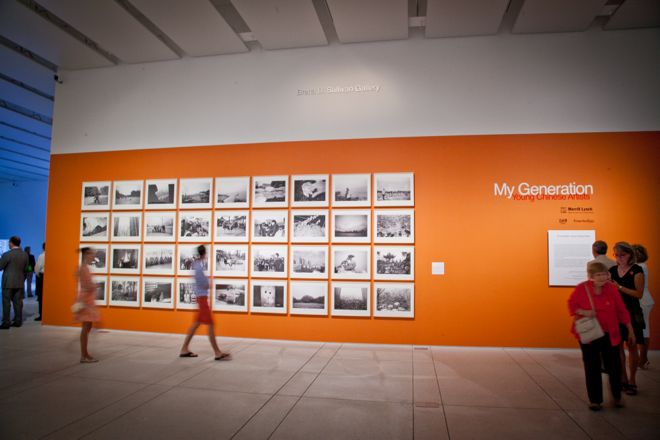
Birdhead, “Light of Eternity No.3”, black and white inkjet print, each: 50 cm x 60 cm (20 in x 24 in), 2012, Courtesy the artists and ShanghART Gallery, Shanghai

